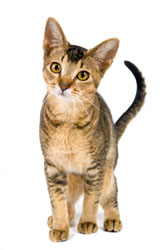Anemia in Cats
 Anemia in cats is a condition in when there is a low red blood cell count or poorly functioning red blood cells. Without enough red cells to grab oxygen molecules during their trip through the lungs, the kitty is in trouble.
Anemia in cats is a condition in when there is a low red blood cell count or poorly functioning red blood cells. Without enough red cells to grab oxygen molecules during their trip through the lungs, the kitty is in trouble.
Signs of Feline Anemia
At home, a caregiver may notice the cat is pale when the cat yawns. Instead of healthy, pink tongue and gums, a pale whitish appearance is present. Note that cats normally have pale pink gums, so the tongue is actually a better barometer for checking color.
If you suspect that your cat is paler than usual, you can gently move the eyelid away from the normal position to expose the conjunctivae, or the mucous membranes surrounding the eye under the lid margins. These are also normally light pink, but they may appear ghostly white in an anemic cat. The third eyelid will pop up from the inside corner of the eye if you put pressure around the eyelids, and this is normally quite pale, so this is not the best place to monitor membrane color.
If there is any likelihood the cat is paler than normal, a visit to the veterinary hospital for a professional assessment is in order. Cats with anemia may be weak and lethargic, sleep more than usual, and if they exert themselves, they may need to pant to get enough oxygen. They may also breathe faster than normal. Certain types of anemia may cause fever and discolored urine.
Diagnosis of Feline (Cat) Anemia
The veterinarian will take a complete blood count (CBC) sample to check the red blood cell count, red blood cell appearance, and other key blood parameters. Other tests may also be recommended such as a feline leukemia virus/feline immunodeficiency virus combo screen, urinalysis, and a blood chemistry panel.
Note that in most cases, it is an abnormal CBC test that will be the first indicator of an emerging anemia condition. The cat may appear quite normal still at home, but the cell count tells another story. A professional assessment of the cat may also provide the first clue, as your veterinarian is very experienced in assessing the mucous membrane color of cats and will often pick up subtle changes in color during the routine physical examination. This may then trigger a recommendation for further testing.
The severity of anemia may range from mild, to moderate, to extreme (life threatening), and it may wax and wane in certain conditions. Routine wellness testing is an important means for your veterinarian to help check your cat for early signs of anemia. In a best case scenario, early intervention will prevent progression to the advanced stages.
What Causes Anemia in Cats?
The most common reasons for anemia are reduced or abnormal red blood cell production by the bone marrow or loss or destruction of functioning red cells. Whether the anemia shows signs of regenerative response can help a veterinarian determine which condition is occuring. Regeneration means that the bone marrow is healthy.
Some specific anemia conditions include:
- Kidney failure. Anemia of chronic kidney failure is primarily associated with reduced stimulation of bone marrow to produce red cells due to low production of the hormone erythropoietin.
- Hemoglobin oxidation. Hemoglobin carries the oxygen inside the cell, so reduced function of the hemoglobin leads to Heinz body anemia or methemoglobinemia. Oxidation interferes with red cell function.
- Blood parasites. These include Mycoplasma haemofelis and Mycoplasma haemominutum, formerly called Haemobartonella felis.
- Blood type incompatibility hemolytic anemia. This is a condition where red cells burst, such as from neonatal isoerythrolysis or transfusion reactions.
- Virus-associated or drug-related bone marrow disorders. These include aplastic anemia from drug reactions or larger than normal red blood cells produced in FeLV-infected cats.
- Parasites. Hookworms or fleas can cause anemia in cats.
- Trauma. Blood loss, such as when a cat is hit by a car or receives a deep, penetrating wound can result in anemia.
- Abnormal red cell production due to inherited conditions. Examples of this include osmotic fragility syndrome, pyruvate kinase deficiency, and congenital porphyria.
- Iron deficiency. This may be seen as a transient condition in young kittens.
- Oxidation. This can be seen when cats are exposed to certain drugs, such as acetaminophen, dietary compounds like onions and propylene glycol, toxins like zinc and moth balls, or certain diseases like complicated diabetes and lymphoma.
How Is Anemia in Cats Treated?
Sometimes, a cat's anemia becomes so severe that a blood transfusion is required. Note that blood is typed in cats before transfusions are done to help reduce the chance of incompatible blood being selected.
In other less severe cases, supportive care is offered while the cat responds to the toxicity, blood loss, or other situation leading to the low red cell counts. Erythropoietin replacement is sometimes used for cats with chronic kidney failure. For some types of anemia, there are no effective treatments. This may be the case with certain cancers or terminal infections that damage cell production in the bone marrow.
Your veterinarian will help you understand the cause of your cat’s anemia, the expected prognosis, and will monitor your cat closely to help determine whether therapy is effective.
You May Also Like These Articles:
The Cardiovascular System of Cats
Cat Fleas: Does My Cat Have Fleas?
How To Take Your Cat To The Vet
How to Be Prepared for Your Cat's Veterinary Bills
Pet Insurance: Peace of Mind for Your Cat's Health
Notice: Ask-a-Vet is an affiliated service for those who wish to speak with a veterinary professional about their pet's specific condition. Initially, a bot will ask questions to determine the general nature of your concern. Then, you will be transferred to a human. There is a charge for the service if you choose to connect to a veterinarian. Ask-a-Vet is not manned by the staff or owners of CatHealth.com, and the advice given should not delay or replace a visit to your veterinarian.





